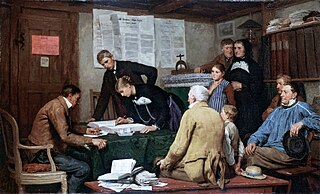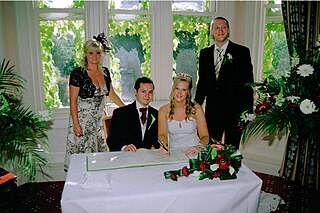
Handfasting is a traditional practice that, depending on the term's usage, may define an unofficiated wedding, a betrothal, or a temporary wedding. The phrase refers to the making fast of a pledge by the shaking or joining of hands.

An engagement or betrothal is the period of time between a marriage proposal and the marriage itself. During this period, a couple is said to be fiancés, betrothed,intended, affianced, engaged to be married, or simply engaged. Future brides and grooms may be called fiancée (feminine) or fiancé (masculine), the betrothed, a wife-to-be or husband-to-be, respectively. The duration of the courtship varies vastly, and is largely dependent on cultural norms or upon the agreement of the parties involved.
The banns of marriage, commonly known simply as the "banns" or "bans", are the public announcement in a Christian parish church or in the town council of an impending marriage between two specified persons. It is commonly associated with the Catholic Church, the Church of Sweden (Lutheran), the Church of England (Anglican), and with other Christian denominations whose traditions are similar. In 1983, the Roman Catholic Church removed the requirement for banns and left it to individual national bishops' conferences to decide whether to continue this practice, but in most Catholic countries the banns are still published.

A civil marriage is a marriage performed, recorded and recognised by a government official. Such a marriage may be performed by a religious body and recognised by the state, or it may be entirely secular.
Same-sex marriage in the Netherlands has been legal since 1 April 2001. A bill for the legalisation of same-sex marriage was passed in the House of Representatives by 109 votes to 33 on 12 September 2000 and by the Senate by 49 votes to 26 on 19 December 2000. The law received royal assent by Queen Beatrix of the Netherlands on 21 December 2000 and took effect on 1 April 2001. The Netherlands was the first country in the world to legalize same-sex marriage.

A Fleet Marriage was a common example of an irregular or a clandestine marriage taking place in England before the Marriage Act 1753 came into force on March 25, 1754. Specifically, it was one which took place in London's Fleet Prison or its environs during the 17th and, especially, the early 18th century.
A marriage license is a document issued, either by a religious organization or state authority, authorizing a couple to marry. The procedure for obtaining a license varies between jurisdictions, and has changed over time. Marriage licenses began to be issued in the Middle Ages, to permit a marriage which would otherwise be illegal.
A shotgun wedding is a wedding which is arranged in order to avoid embarrassment due to premarital sex which can possibly lead to an unintended pregnancy. The phrase is a primarily American colloquialism, termed as such based on a stereotypical scenario in which the father of the pregnant bride-to-be threatens the reluctant groom with a shotgun in order to ensure that he follows through with the wedding.

Elopement refers to a marriage conducted in sudden and secretive fashion, usually involving a hurried flight away from one's place of residence together with one's beloved with the intention of getting married without parental approval. Elopement is contrasted with abduction in which there is no consent from the bride or groom.
Quaker weddings are the traditional ceremony of marriage within the Religious Society of Friends. Quaker weddings are conducted in a similar fashion to regular Quaker meetings for worship, primarily in silence and without an officiant or a rigid program of events, and therefore differ greatly from traditional Western weddings.

A sham marriage or fake marriage is a marriage of convenience entered into without intending to create a real marital relationship. This is usually for the purpose of gaining an advantage from the marriage.
A schepen or échevin (French) or Schöffe (German) is a municipal officer in Belgium and formerly the Netherlands. It has been replaced by the wethouder in the Netherlands.

Marriage is available in England and Wales to both opposite-sex and same-sex couples and is legally recognised in the forms of both civil and religious marriage. Marriage laws have historically evolved separately from marriage laws in other jurisdictions in the United Kingdom. There is a distinction between religious marriages, conducted by an authorised religious celebrant and civil marriages conducted by a state registrar. The legal minimum age to enter into a marriage in England and Wales is eighteen years. Certain relatives are not allowed to marry. For foreign nationals, there are also residency conditions that have to be met before people can be married. Same-sex marriage was introduced under the Marriage Act in March 2014.

Halpern v Canada (AG), [2003] O.J. No. 2268 is a June 10, 2003 decision of the Court of Appeal for Ontario in which the Court found that the common law definition of marriage, which defined marriage as between one man and one woman, violated section 15 of the Canadian Charter of Rights and Freedoms.

Marriage law refers to the legal requirements that determine the validity of a marriage, and which vary considerably among countries. See also Marriage Act.

An engagement party, also known as a betrothal party or fort, is a party held to celebrate a couple's recent engagement and to help future wedding guests to get to know one another. Traditionally, the bride's parents host the engagement party, but many modern couples host their own celebration.

The marriageable age is 16 with parental consent but 18 otherwise. Marriage must be between two otherwise unmarried people. If one of the parties wishing to marry is subject to immigration control, notice of marriage can only be given at a register office, which both parties must attend together. The UK Government was obliged, under the Northern Ireland Act 2019, to extend same-sex marriage to Northern Ireland by secondary legislation that took effect on 13 January 2020. Until then, same-sex marriages from other jurisdictions were treated as civil partnerships. Civil partnerships became available to same-sex couples in December 2005 and grant rights and responsibilities identical to civil marriage.

The Marriage Act, 1961 is an act of the Parliament of South Africa governing the solemnisation and registration of marriages in South Africa. It does not deal with the dissolution of marriages, which is governed by the Divorce Act, 1979, or with matrimonial property regimes and the financial consequences of marriage, which are governed by the Matrimonial Property Act, 1984. Some issues relating to marriage remain governed by the Roman-Dutch common law because they have never been addressed by Parliament.

The Clandestine Marriages Act 1753, long title "An Act for the Better Preventing of Clandestine Marriage", popularly known as Lord Hardwicke's Marriage Act, was the first statutory legislation in England and Wales to require a formal ceremony of marriage. It came into force on 25 March 1754. The Act contributed to a dispute about the validity of a Scottish marriage, although pressure to address the problem of irregular marriages had been growing for some time.

A civil, or registrar, ceremony is a non-religious legal marriage ceremony performed by a government official or functionary. In the United Kingdom, this person is typically called a registrar. In the United States, civil ceremonies may be performed by town, city, or county clerks, judges or justices of the peace, or others possessing the legal authority to support the marriage as the wedding officiant.